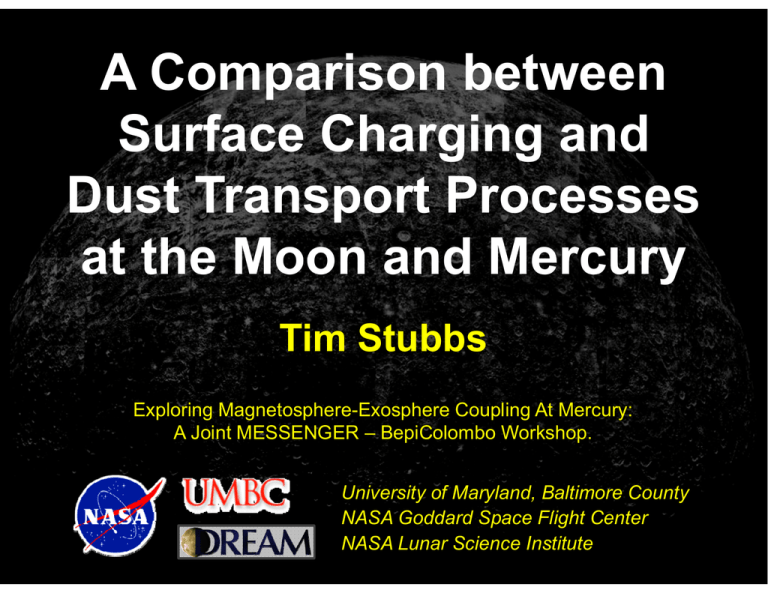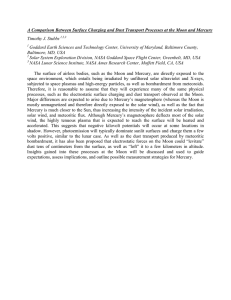A Comparison between Surface Charging and g g Dust Transport Processes
advertisement

A Comparison between Surface Charging g g and Dust Transport Processes at the Moon and Mercury Tim Stubbs Exploring Magnetosphere-Exosphere Coupling At Mercury: A Joint MESSENGER – BepiColombo p Workshop. p University of Maryland, Baltimore County NASA Goddard G dd d Space S Flight Fli ht C Center t NASA Lunar Science Institute Motivations and Objectives j COMPARATIVE PLANETOLOGY: Like the Moon, the surface of Mercury is exposed to various plasma populations, as well as solar UV radiation, and becomes electrically charged. Evidence from the Apollo era suggests that a greater abundance b d off d dustt can exist i t iin th the llunar exosphere h th than can be explained by meteoritic ejecta alone. “Lunar horizon “L h i glow” l ” (LHG) believed b li d tto b be caused db by sunlight li ht scattering from exospheric dust was observed near the surface and at high altitudes. It has been proposed that these dust populations were electrostatically transported. Predict surface potentials and electric fields at Mercury’s surface for various plasma environments. Suggest how to search for exospheric dust at Mercury with MESSENGER based MESSENGER, b d on strategies i being b i considered id d ffor the h Moon with LADEE UVS. The Lunar Plasma (and Dust) Environment Figure from “Heliophysics Science and the Moon” report from the NAC Dynamically Coupled System Galactic Cosmic Rays (GCRs) Solar Energetic Particles (SEPs) Solar Flares Coronal Mass Ejections (CMEs) Outgassing Sputtering Surface Electric Field − − − − − − − − − +++++++++ Composition Charrged Dus st Ar+ Ne+ Na+ K+ O+ Hot & Tenuous Magnetospheric Plasmas Solar UV & X-rays Plasm ma Shea ath Ar Ne Na K H2O Solar wind Plasma Ionosp phere Exosp phere Meteoritic Flux Topography Magnetic Anomalies + − + Ejecta Weathering Mercury’s Magnetosphere & Plasma Environment Mariner 10 and MESSENGER: globalscale dipolar magnetic field and a dynamic magnetosphere. This significantly modifies the plasma environment at the planetary surface. Slavin [2004] Mercury’s magnetosphere is somewhat Earth-like with a plasma sheet and lobes in the tail and cusps at the dayside. Lunar Surface Charging in the Solar Wind Lunar Prospector n Observ vations Electron Simple charging model: photoemission, plasma electron and ion currents. Solar wind electrons are “typically cool”, so can ignore secondaries. LUNAR WAKE Non-Maxwellian: Non Maxwellian: Electrons heated in the wake by infilling process. process ~ −200 V Surrface Cha arging Predictio ons ~ +4 V ~ −40 V ~ −4 V m–1 Stubbs et al. al [2007] Find equilibrium potential eq – net current is zero. E-field sweet spot at the terminator. Direct Observations of Lunar Surface Charging (E t (Extreme C Case)) 4 keV beam of secondary electrons accelerated upward by negative surface potential. Energy-dependent loss cone indicative of repulsive surface potential. • High energy electrons l t hit th the surface and are lost H l k ett al.l [2007] Halekas • Low energy electrons are reflected by the potential. It’s not possible to make similar measurements with MESSENGER because of the energy range of the electrons involved … may be possible with BepiColombo, depending on the orbit altitude. A Comparison Between Lunar Surface Ch Charging i in i the th Solar S l Wind Wi d and d Magnetotail M t t il Typical plasma conditions – ISEE ISEE-3 3 electron data [Slavin et al., 1985]. Condition n [cm−3] Te [eV (K)] Ti [eV (K)] V [km s−1] 10 12 1 (1 12.1 (1.4 4 × 105) 8 6 (1 8.6 (1.0 0 × 105) −400 400 Tail lobes 0.02 86 (1.0 × 106) 86 (1.0 × 106) * −170 Plasma sheet 0.2 216 (2.5 × 106) 1577 (1.83 × 107) # −100 Slow solar wind Assumptions: * Ti = Te and # Ti = 7.3Te. Dayside S Nightside S Electron current Je00 Slow solar wind ~ +4 V ~ −50 V ~ 1.0 μA m−2 Tail lobes ~ +10 V ~ −325 V ~ 10−2 μA m−2 Plasma sheet ~ +6 V ~ −600 V ~ 10−1 μA m−2 Condition Dayside y –p photoemission dominates p plasma electron currents Nightside – plasma electron currents (Temperature) dominate. Surface Charging at Mercury Mariner 10 observations [Ogilvie et al., 1977] - Cool plasma sheet: ne ~ 5 cm–3 and Te ~ 200 eV - Hot H t plasma l sheet: h t ne ~ 1 cm–33 and d Te ~ 1000 eV. V Hot electrons – secondary emission could be important. Use the Sternglass [1954] relation with EM = 400 eV, δM = 1.5 & Ts = 3 eV [Willis et al., 1973]. N Nightsid de Days side Cool Plasma Sheet Hot Plasma Sheet – Nightside Jtotal eq ≈ +4.2 V Jph eq ≈ –2170 V Jsec Ji Ji Jtotal Jsec eq ≈ +1.0 V Currents: Jph = photoemission of electrons; ; Ji = plasma l ions; i Js = secondary electrons; Jtotal = total. Nig ghtside e Daysid de Importance of Secondary Electron Currents Cold plasma sheet: if Jsec is included,, then eq ≈ +4.2 V. EM if Jsec is NOT included, then eq ≈ +3.5 V. Difference is relatively small, so Jsec is NOT dominant. The value of eq is typically dominated by Jph and . Cold plasma sheet: if Jsec, is included, then eq ≈ +1.0 V. if Jsec is NOT included, then eq ≈ –750 V. Difference is HUGE, so Jsec is a dominant current. EM ~ kTe Hot plasma sheet: if you include i l d Jsec, then th eq ≈ –2170 2170 V V. if you do not include Jsec, then eq ≈ –3750 V. EM g , difference is HUGE,, so Jsec is a dominant current. Again, The value of eq is typically dominated by Jsec and ~ kTe . < kTe Surface Charging Variation with Location Predictions of surface potential, S, and surface electric field, ES, as a function of angle from the subsolar point, θ. (θ = 0° is equator at noon and θ = 90° is at sunset/sunrise) Equator/Mid-Latitudes Hot Plasma Sheet Cool Plasma Sheet Polar Regions (and Equator?) Solar Wind without Jsec Dayside: Jph appears to dominate under all conditions, so S ~ +4 V. Nightside: S varies considerably (~ ( +1 1 V to –2 2 kV!). In the polar regions, Jsec does not dominate under the solar wind-like conditions. EM > kTe Evidence for Dust Above the Lunar Surface Colwell et al. al [2007] Horizon glow from forward scattered sunlight • Dust grains with radius of 5 – 6 μm at about 10 to 30 cm from the surface, where electrostatic and gravitational forces balance. • Horizon glow ~107 too bright to be explained by micro-meteoroidgenerated ejecta [Rennilson and Criswell, 1974]. In--Situ Evidence for Dust Transport In Terminators Berg et al. [1976] Apollo 17 Lunar Ejecta and Meteorites (LEAM) experiment experiment. Dust Observed at High Altitudes from Orbit Sketches of sunrise with “horizon glow” and “streamers” viewed from lunar orbit during Apollo 17. Highlighted are the sources of the scattered light: Coronal and Zodiacal Light (CZL) – RED; Lunar Horizon Glow (LHG) due to exospheric dust – BLUE; and possibly “crepuscular rays” formed by shadowing and scattered light – GREEN. Predictions for LADEE Star Tracker Camera LADEE “might” be able to use Star trackers, like the Clementine mission. Observations from a broadband imager would be great for providing context – although wavelength info would be better. Predictions in kR nm−1 for altitude = 50 km and SZA = 110 110° (from within lunar shadow). Exospheric dust model b based d on A Apollo ll era observations [Murphy and Vondrak, 1993]. MDIS ??? Stubbs et al. [2010] – modeling by Dave Glenar (NMSU) Predictions for LADEE Ultraviolet Spectrometer (UVS) LADEE UVS has ≈ 1° FOV with ≈ 0.7 nm. Predictions for observations from within lunar shadow just above limb limb. Fraunhofer (solar) lines are important. Lunar Horizon Glow (LHG) is “bluer”. Coronal and Zodiacal Light (CZL) is “redder”. Stubbs et al. [2010] – modeling by Dave Glenar (NMSU) Possibility of making similar observations at Mercury with MASCS? Better to focus on the blue part of the spectrum (< 500 nm) where we would anticipate Hermean Horizon Glow (HHG) to dominate. Scan to get intensity as a function of tangent height (altitude at the limb). Need to characterize CZL as observed from Mercury – intrinsically interesting! “Dust-electron” dominated lunar ionosphere? Radio occultation measurements by the Soviet Luna 19 and 22 missions indicated electron concentrations of ~103 cm−3 ! Much higher than expected ~1 cm−3. Estimated electron concentrations produced by photo-charged exospheric dust using dust concentrations inferred from Apollo 15 coronal photographs. Θ: scaling parameter to account for uncertainties and variability (mostly in dust concentrations?). Dust-electrons are the most plausible mechanism for producing the observed b d lunar l ionosphere. Stubbs et al., 2010, under review. These processes at Mercury have been considered id d before: b f Ip, I GRL, GRL 1986. 1986 Qualitative discussion of the phenomena. Rough estimate for surface charging – up to kilovolts negative. Speculated that charged dust produced via meteoritic ejecta could f form a dust d t coma or tail. t il Grard [1997] also considered surface charging at Mercury and the dayside photoelectron sheath. Negative g Dust EC Summary and Conclusions Comparative planetology: the Moon and Mercury have a lot in common, especially the space environment interaction with the surface regolith. The surface of Mercury is electrically charged: – negative kilovolt potentials should be fairly common. – secondary emission of electrons is often important. Extremely important to take into account when considering the magnetospheric t h i iinteraction t ti with ith M Mercury. Could be electrostatically transported dust at Mercury –worth a look! N t sure what Not h t to t expectt … could ld be b many controlling t lli factors f t – plasma environment, meteoritic flux, regolith composition, shape p and p particle size distribution,, etc … Instrument considerations: viewing geometries, solar avoidance. Consequences for exosphere, exosphere ionosphere and magnetosphere. magnetosphere Subtle influence on the evolution of the regolith (dust component).


